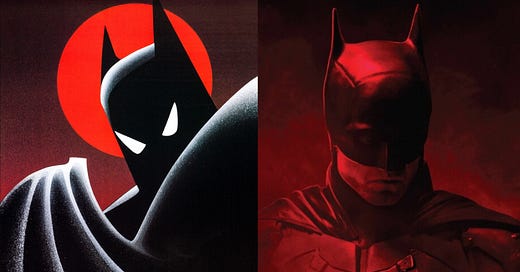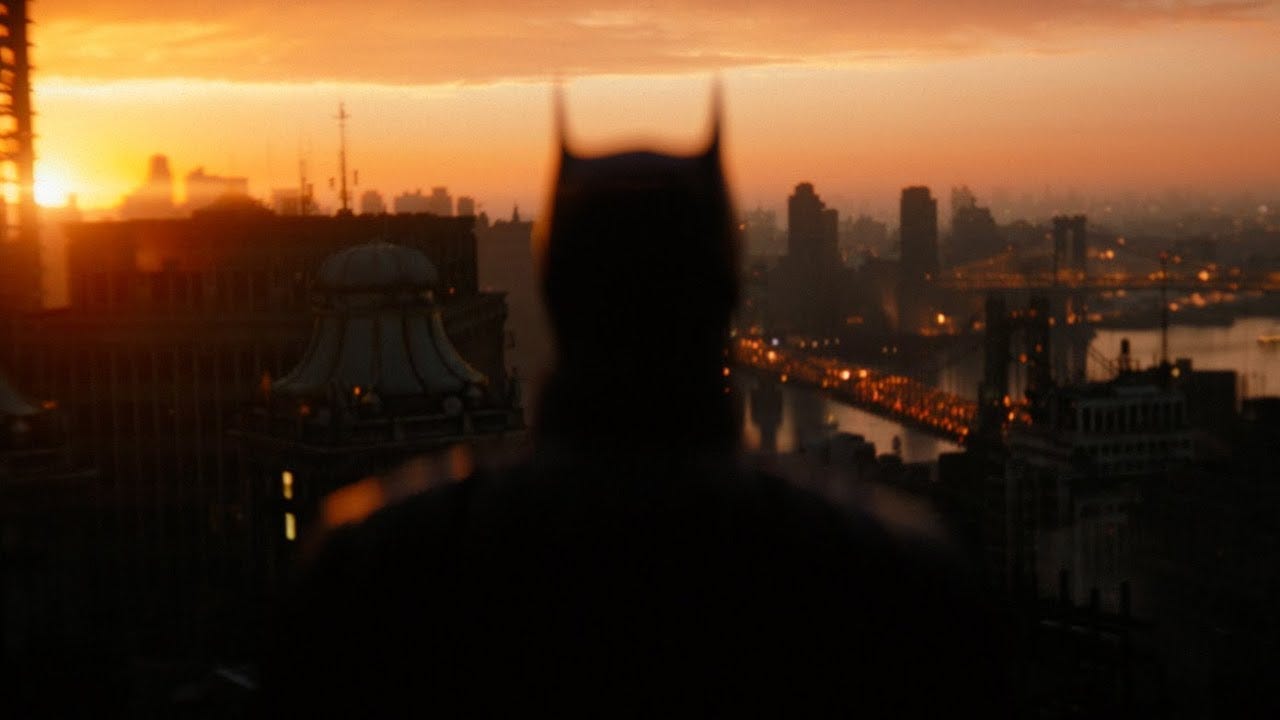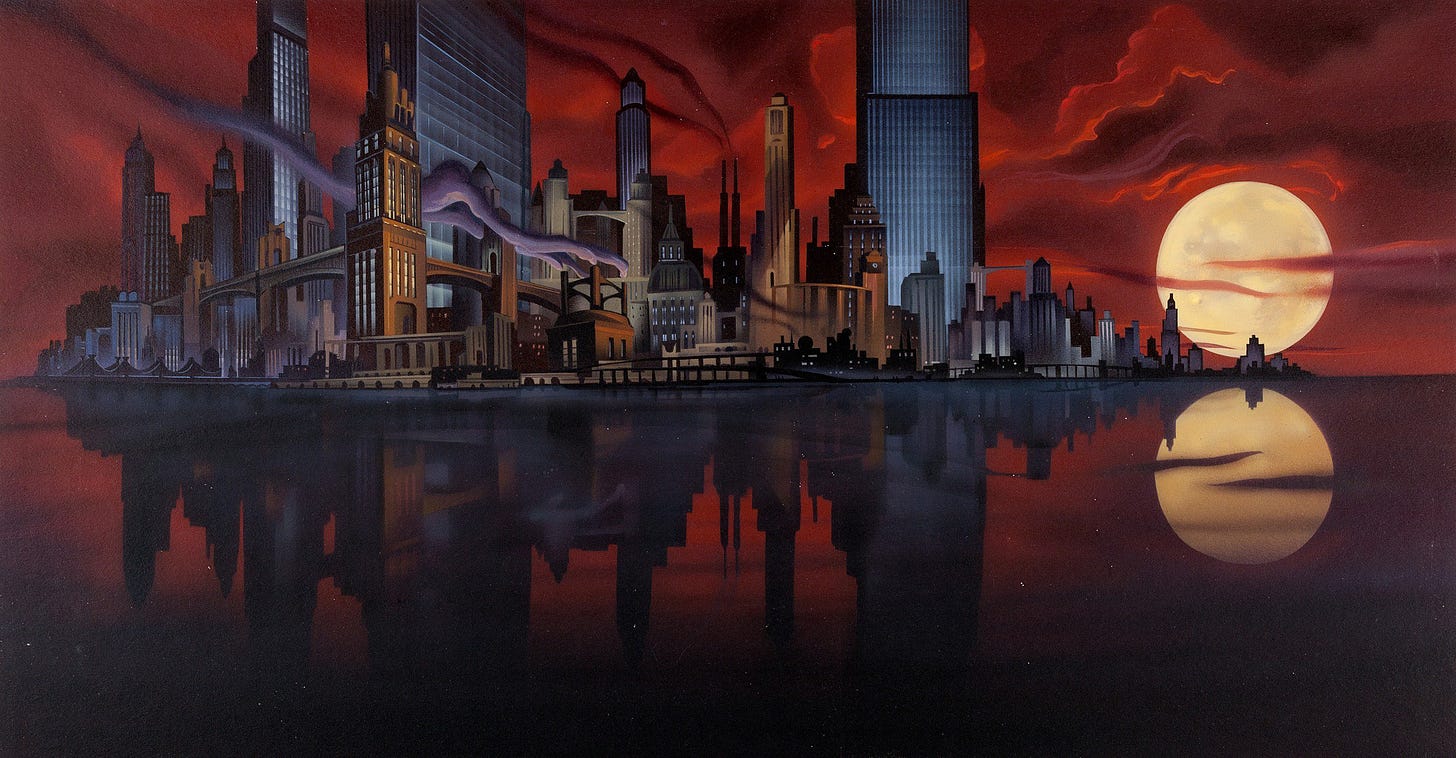'The Batman' and The Animated Series
Batman: TAS shines in all the places Matt Reeves' film flickers out.
Batman has been dark and gritty for a long time now. The late-century one-two punch of Frank Miller’s sobering comics and Tim Burton’s gothic fantasy films cemented public perception of the character as a dark, scary marauder of vengeance, so much so that almost every iteration since has adopted some rendition of those works’ darker sensibilities.
Over the years, this trend toward a more solemn Batman has, in some cases, been twisted into a dumber, more absolutist mantra of “darker is better,” many adaptations zeroing-in, with magnified lens, on Batman’s sociopathy and trauma and the brutality of his violence. There is, of course, nothing wrong with an artist focusing on the aspects of the character they find most interesting. But the problem with a magnifying glass, as any good detective would tell you, is that it can keep you from seeing the bigger picture.
This weekend’s The Batman—a long, droning requiem for all the ugliest elements of the character—is the latest in a tired line of gritty Batman stories to fall into this trap. By no means is it the first to sacrifice depth, intrigue, or heroism for bleaker, been-there-er aesthetics, but it is likely the most high-profile—and thus, the most frustrating—example in recent memory.
Many seem to be loving it; more power to them! I certainly wouldn’t want anyone to dislike this movie, as it’s a very long one to not enjoy. But I have to question the continued cultural and financial returns on an iteration as dour as this. How many more gritty-for-the-sake-of-it Batman stories can we tell before audiences realize they’ve been seeing the same ideas, re-packaged over and over in darker plastic and diluted down to make room for more empty-calorie sadness?
The hype surrounding Matt Reeves’ take on the Dark(est) Knight shows that there is still an audience for a moody-n’-broody Batman—truth be told, prior to seeing it, I would’ve counted myself among them. I like my serious Batman stories with emotional heft and moral drama! Who doesn’t?
But a dark-as-possible, rooted-in-reality Batman is, frankly, just getting stale. Christopher Nolan did it. The Arkham games did it. Zack Snyder overdid it. The comics have done and overdone it multiple times. It’s become a tired game of one-upmanship to see who can make the grittiest Caped Crusader. And if most audiences don’t agree, I believe that before too long, they will start to. The Batman has already proven less uniformly loved among critics and casual moviegoers, even if movie buffs and superhero fans seems fairly united in support.
In telling Batman stories, there’s a balance worth seeking out between darkness and light; self-seriousness and spectacle; tragedy and triumph. In the three decades since Burton and Miller redefined the character, one adaptation has stood out among the rest for its uncanny ability to find that balance, as well as earning the respect and favor of fans all across the Bat-spectrum: artist Bruce Timm and writer Paul Dini’s Batman: The Animated Series.
When conceiving the show in the early ‘90s, Timm and Dini chose to found their animated Batman in the dark fantasy atmosphere of Burton’s films, but imbue in it noir storytelling and an appeal to younger audiences. The result would prove the character to be an accessible vessel for children’s stories without sacrificing the shadowy imagery of Burton's films or the moral complexity of Miller's comics. This blend of fantastical adventure and weighty themes makes for one of the most perfectly realized iterations in all of Batmedia.
It’s worth revisiting BTAS, especially alongside The Batman, as I think the series highlights many of the issues at-hand in Reeves’ version, even beyond the greater context of previous adaptations that cause its “darker is better” motto to feel like a lazy approach to the character in 2022.
One of the easiest points of comparison would be the visual style. The Batman cinematographer Grieg Fraser is no-doubt one of the most highly skilled artists working today, and this film is confidently rendered in his hands. But it is nevertheless another round of Realistic Gotham that takes pieces of New York and Chicago and lightly paints over them with a dirty brush. There’s more identity here than in Nolan’s version of Gotham—which is essentially just plain-old Chicago—but the early minutes of Reeves’ film promise a living, terrified city that never really comes to fruition after we meet its masked guardian.
It’s not an ugly movie, by any means, but it is a frustratingly reserved one, with Fraser’s best shots and the most intriguing set designs being edited down and pushed off to passing glances by Reeves’ insistence that his repetitive police procedural is more interesting. Most of the film consists of drab, fluorescent interiors and rain-obscured streets. It’s an aesthetic that feeds the tone of the film—it just isn’t a particularly unique or engrossing one.
Contrast this with the Gotham of Timm and Dini’s stories: a densely-packed array of art-deco skyscrapers, awash in inky black shadow and silhouetted against a blood-red sky. BTAS took many visual notes from Burton and removed them further from reality, putting characters in 1930s or ‘40s clothing and cars while equipping them with modern and even futuristic tech. They even threw a few blimps in the sky for good measure. It’s a gothic, retro-future urban jungle that exists entirely out of time and not anywhere familiar. It’s a mouth-watering fantasy to imagine what modern visual effects, both practical and digital, could do with such a dynamic visual palette. Instead, here; have Chicago 2.
More importantly, this visual style helps emphasize the key balance at the center of BTAS’s storytelling. A timeless, dreamy Gotham, befit for an episode of The Twilight Zone, helped its grim morality plays and the tragedy of its titular hero to feel familiar enough to register emotionally, but still otherwordly enough to allow for its adventures to reach into the fantastical, and to not be bogged-down by real-world analogues.
What, precisely, does The Batman’s visual style do—beyond reminding you, along with every other aspect of the film, that this is a sad, gloomy place full of sad, gloomy people? It’s Gotham; of course it’s depressing. I don’t need every frame to remind me of that.
Take me on a journey; show me the highs and lows of the city so that Gotham’s growing class divide becomes visually integrated into the world, instead of just being stated on newscasts. Give me a vibrant, mysterious, scary backdrop against which Batman can make his crusade. Batman does not exist in our reality, nor could he; give me a Gotham to match the character’s inherent fantasy. Nolan already did a real-world Batman about as well as one can, and even then, it crumbled in its final outing. Why are we attempting that all over again?
This horse-beating insistence on dour realism obviously extends far past the optics. The Batman is obsessed with expressing—through cold, heartless stares and expository dialogue—just how fucked-up Batman (and the world around him) is. If not for the tacked-on (and, I’d argue, completely unearned) ending message of hope, The Batman would have otherwise been an exercise in full-tilt nihilism, an indulgence many Batman stories—very few great ones—have taken.
BTAS is the perfect example of how to build optimism into the character, while still dealing with heavy subject matter and challenging emotions. In any given episode, viewers could be subjected to themes of guilt, grief, addiction, revenge, class struggle, the desire for others’ acceptance, and more. But each somber fable is anchored by a lesson that these dark feelings or realities don’t have to be the norm. There is hope at every turn for self-improvement, compassionate community, and widespread, meaningful change. And we actually see Batman and other characters figure that out over the course of an episode, rather than having it handed out through perfunctory narration after the climax.
At the center of BTAS’s storytelling, we have a Batman whose Bruce Wayne isn’t jettisoned for convenience, but rather preserved—even put in the spotlight, on occasion—in order to highlight the relationship between his two identities and the double-edged nature of his commitment to crime-fighting. Episodes like “Perchance to Dream” and the tie-in feature film Mask of the Phantasm (which is essentially an extended episode of the series) serve to explore the unmasked man who, deep down, wants a life of his own. He fakes his way through snooty, upper-class engagements and public appearances, but the love and loss he feels throughout his day-to-day life is genuine.
Robert Pattinson’s Bruce is little more than a hollow puppet, accumulating dust on a shelf in Wayne Tower until the rare occasion in which Batman decides to trot him out so he can investigate something in the public eye. Reeves attempts, two hours in, to mend what he clearly realized was a mistake, in giving Bruce no substance or heart apart from the cape and cowl, by making a hospitalized Alfred exposit family history to which Bruce can reactively tell us a bit about himself. It’s too little, too late, sadly, made all the more infuriating by film’s the bloated, unoptimized runtime and the fact that BTAS could accomplish, in 20 minutes, more character development than The Batman even attempts.
I say “Pattinson’s Bruce” only for clarity, and I don’t remotely blame his acting ability for the lackluster character. Unfortunately, he’s up against a performance with far better written material and a perfectly dialed-in portrayal of both sides of the Bat. Kevin Conroy’s subtle tone-shifting when playing each identity is something I’ve not yet seen replicated to the same effect in live-action. The mere implication behind Batman’s voice being his real voice, and Bruce’s overly sunny timbre being the facade, is more potent a depiction of the intrapersonal relationship that forms Batman than any over-the-top gravelspeak could accomplish.
It’s worth noting that I don’t inherently reject the notion of a Bruce Wayne who is a grungy, emotionally stunted man-child. At some level, most versions of the character could be described that way. But it’s an overly obvious and lazy way to completely define him at this point in his storied history.
On the bright side, The Batman’s latter-half gestures at character development could signal that Reeves is saving the exploration of Bruce’s personality and depth for sequels. It’s just a frustrating omission in a movie that’s this long and has so little to say about the character.
To move beyond Batman himself, it’s worth discussing the other members of the Bat Family. This is less a direct point of critique against The Batman than it is me generally waving my arms at all live-action Batman movies of the 21st century, but if these films really wanted to do something bold with the character and highlight one of his most intriguing elements, forget the dark and gritty crime procedurals—let’s see some Robins, Nightwings, and Batgirls.
BTAS showed the potential of stories about Batman’s wards to give new dimension to Batman as a leader, mentor, father, and friend, and explored its main character’s significant shortcomings in these respects. It’d be fascinating to see a live-action film grapple with not only the morality of roping kids and young adults into the crime-fighting life, but also the meaningful relationships that develop within that unique space; not to mention the added emotional depth of giving Bruce more characters to bounce off of and grow alongside.
It’d make for some cool action too! We’ve now gotten to see what multiple Spider-Men in a fight looks like; let’s see multiple Bat People in a fight!
I suspect Joel Schumacher’s Batman & Robin is the prime suspect for why live-action adaptations have been so skittish to deal with the Bat Family, but that’s a pretty poor excuse. Countless comics, cartoons, and video games have maintained Robin’s and Batgirl’s popularity; it’s not like you can’t tell serious, engaging stories with them in it. I’m not sure I can imagine Pattinson’s Batman taking a child under his wing, but who knows. Maybe in whatever iteration follows.
While I don’t really blame Reeves for avoiding Robin and other Batfolk in his first outing, I think that speaks to another grating frustration with The Batman: it doesn’t feel like it opens up a lot of possibilities. Instead, it seems to continue the trend of cornering the character into a specific, melancholic wheelhouse. Just as I can’t imagine the concept of Robin working in this world, I also struggle to picture many of Batman’s zanier villains being a good fit. BTAS gave us pretty much every bizarre A- and B-list Batman villain we could possibly want, and did most of them incredibly well. In Reeves’ movies, are we forever stuck with mob bosses and true-crime serial killers?
Reeves has suggested that he likes the idea of Mr. Freeze and would be interested in bringing him back to the big screen in a “grounded” way, whatever that means. That gives me some small bit of hope that Batman’s more fantastical foes are not out of the realm of possibility in the Battinson universe. Does one of Batman’s gadgets in the film imply the existence of Bane? While we’re at it, let’s see the Mad Hatter, Clayface, or Killer Croc! Man-Bat, anyone? That being said, the film’s ending stinger dredges up another boring choice of villain, so it’s hard to know what to expect from sequels.
Look, all these comparisons to BTAS are not simply to say, “New bad, old good!” I love The Animated Series, and I stand by my claim that it’s one of the best, if not the best, and most well-rounded adaptations of the mythos in existence. But my point in highlighting the series’ strengths is to show all the possibilities the character provides. Darker, grittier, sadder, and more realistic is not the only way to go, despite what Warner Bros would have you think. I miss seeing high-flying Bat-themed adventure on the big screen.
And you don’t have to sacrifice gravity for fun. For as heady and dramatic as they were, even the Nolan films understood the value of spectacle and the spirit of adventure in these stories. The Dark Knight Rises features a Batcopter, and Bane disintegrates a football stadium, for Pete’s sake. Those movies are the crown jewel of “very serious Batman films,” yet they still made room for over-the-top setpieces and a general sense of fun.
But it can be taken several steps further. For all their flaws, the Marvel films generally embrace their comic roots, putting the weirdest, wildest, and most colorful stuff to screen. People still take those movies seriously, and many of them are genuinely moving; it doesn’t have to be a trade-off. It’d be neat to see Batman films do the same, the way Batman: The Animated Series did.
Maybe The Batman was just a trial run for Reeves, to see what he likes about the character and find his footing. Maybe the ending of the film is indeed setting up a brighter, more colorful Gotham with wilder threats ahead. But its drip of depression and realism certainly seem to reinforce the trend of boring, brooding Batman stories that have little to say, and say it sadly.
Here’s hoping Reeves can surprise me and redirect the tone of the series in a sequel, because after that promising opening weekend, I don’t think Battinson is going anywhere too soon.








